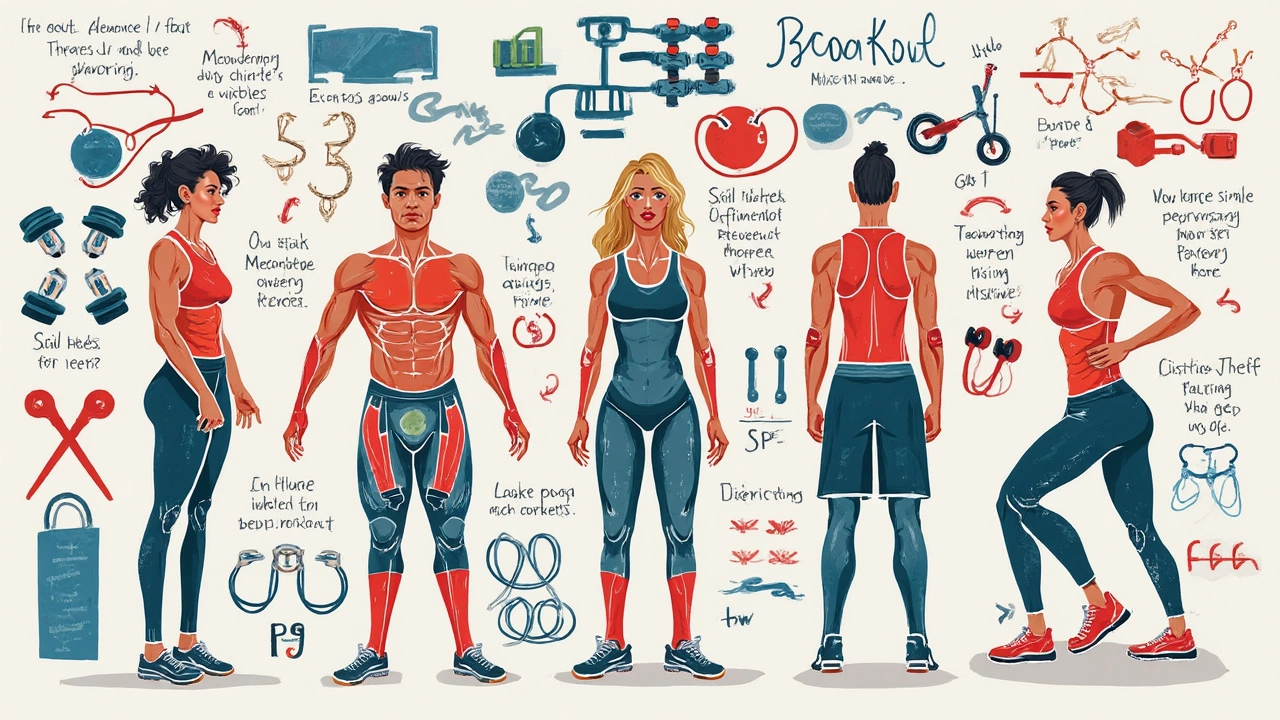
Finding the right workout plan can feel like searching for a needle in a haystack. Everyone seems to have their own take on what works best, and it leaves you wondering if there's a one-size-fits-all solution. Spoiler alert: there's not. It all boils down to your personal fitness goals and what you're comfortable with.
First things first, what are you aiming for? Do you want to build muscle, lose weight, or just feel more energetic throughout the day? Defining your goal is like setting a GPS route for your fitness journey. If muscle gains are your thing, a strength training program might be your go-to. But if shedding pounds is your top priority, incorporating more cardio could be beneficial.
What's your schedule like? Between work, family (hello, Elowen!), and attempting to have a life, finding time to hit the gym can be tough. You might need a plan that fits into your busy day without feeling like just another box to tick. Remember, consistency trumps intensity. The best workout plan is one you can stick to.
So, you've decided to embark on a fitness journey. That's awesome! But before you dive into any workout plans, it’s super important to know what you really want to achieve. Defining your fitness goals is like having a roadmap. Without it, you might find yourself lost on where to go next.
Start by asking yourself some basic questions. Do you want to get stronger, leaner, faster, or just feel healthier overall? Maybe you have more specific goals, like running a 5K or being able to lift a certain weight. Whatever your goal, write it down. It makes the whole idea more real.
Understanding the different types of workouts can also help you match your goals. For instance, strength training is fantastic for building muscle and toning your body. On the flip side, cardio is great for boosting endurance and burning calories. If you're just getting started, mixing a bit of both might be the perfect blend.
Here's another thing to consider: your lifestyle. A workout plan that's great for someone with a flexible job might not be ideal for a busy parent. Make sure your fitness plan fits your life. You want this to be sustainable, not stressful!
Want some insider tips? Experts often recommend the SMART method for goal-setting. SMART stands for Specific, Measurable, Achievable, Relevant, and Time-bound. For example, instead of saying "I want to be fit," try "I want to lose 10 pounds in 3 months by working out 4 times a week." It makes your goal concrete and gives you a timeline to keep you on track.
Let's take a quick look at how workout goals can vary:
| Goal | Recommended Workouts | Frequency |
|---|---|---|
| Weight Loss | Cardio, HIIT | 3-5 times a week |
| Muscle Gain | Strength Training | 4 times a week |
| Increased Flexibility | Yoga, Pilates | 2-3 times a week |
| Endurance | Running, Cycling | 3 times a week |
In the end, whatever your goal is, the most important part is getting started and staying dedicated. Your journey is personal, and what works for others might not work for you. Listen to your body, adjust your plan as needed, and enjoy the transformation. You've got this!
Alright, let’s face it: the eternal debate of cardio versus strength training doesn’t seem to be going away anytime soon. Both have their fan clubs, and each camp holds its own benefits depending on what you're aiming to achieve. So, what’s the real deal? Which should you be doing more of?
Cardio workouts, like running, cycling, or anything that gets your heart pumping, can do wonders for your endurance. They help burn calories, which is great if you’re looking to lose weight. Cardio is king when it comes to improving your heart health and getting those endorphins flowing.
On the other hand, strength training focuses on lifting weights or using resistance to build muscle. This doesn’t just mean bulking up; it’s also about strengthening your bones and increasing your metabolism. Yep, that's right, building muscle helps you burn more calories even at rest. Talk about efficiency!
Now, some folks like to look at the numbers, and honestly, who doesn’t? Here’s a simple comparison:
| Workout Type | Calories Burned per Hour |
|---|---|
| Running at 6 mph | 600 |
| Weightlifting (general) | 220 |
It's tempting to just look at these numbers and declare a winner, but remember, it’s not just about the immediate calorie burn. Strength training builds lean muscle, giving your metabolism a long-term boost.
So, how do you choose? It depends on your goals. Want to improve your stamina and enjoy a good heart workout? Cardio might be your best bet. Looking to tone up, lose weight and improve your overall fitness in a balanced way? Incorporating strength training can be a game-changer.
And hey, why not do both? Many effective workout plans combine cardio and strength training. Think about it: a few days of intense cardio, mixed with some strength sessions, can provide a well-rounded routine. This combo not only helps in losing weight but also tones muscles and keeps boredom at bay. Mixed workouts often ensure you’re hitting various muscle groups and keeping things exciting.
In the end, the best plan is one you enjoy and can maintain. Explore what gets you excited and fits into your lifestyle. Once you find what works for you, chasing your fitness goals will feel less like a chore and more like an adventure.

Feel like you're caught between a love of both strength training and cardio? You don't have to choose just one. Hybrid plans combine the best of both worlds, giving you a balanced approach to fitness that can help you reach diverse goals.
So, what is a hybrid workout plan exactly? It's a clever mix of different types of exercises meant to improve overall fitness. These plans can help you build muscle, improve cardiovascular health, and often make working out less monotonous. You're not stuck doing the same thing every day, which can be a serious mood booster.
One popular approach is circuit training, where you switch between resistance exercises and cardio moves with little to no rest in between. For example, you might do a round of push-ups, followed by jumping jacks, then move on to squats in a fast-paced circuit. This not only burns a ton of calories but also builds strength.
Runners might enjoy mixing running with strength days. Imagine alternating a long run with a day focused on leg and core strength exercises like lunges and planks. This can help improve running performance while also reducing the risk of injury. Plus, it keeps things interesting!
Research suggests that hybrid plans can be particularly effective for losing body fat while retaining muscle mass. This is great news if you're looking to cut weight or tone up without sacrificing your hard-earned muscles. Keep in mind, though, it's essential to listen to your body and adjust intensity as needed.
Here's a simple example of a hybrid weekly routine:
This approach can cater to busy schedules, with flexibility to swap days as you see fit. Remember, the goal is a plan you enjoy and can maintain over the long haul. If morning sessions are your jam, go for them! The universe of workout plans is pretty vast, so feel free to tweak things until it feels just right for you.
So you've picked a workout plan, and you're all pumped up to start. But wait—it’s often not starting that's hard, it’s keeping it going. We've all been there; the first couple of weeks can feel like a breeze, but what happens after the initial excitement fades?
First off, let’s talk about setting smaller, achievable goals. Think of them like stepping stones. It’s easier to stay motivated when you have targets that don’t feel miles away. If you’re aiming to run a marathon, start with running a 5K, then a 10K, and so on. Each milestone is a little victory, cheering you on.
Don’t underestimate the power of routine. Your brain loves patterns, and once you integrate your fitness routine into your day, it becomes a part of your lifestyle. Pick specific days and times for workouts and stick to them just like any other important appointment. Flip the switch from asking, "Do I have time to exercise today?" to "It’s exercise time."
Variety is your friend. Mix your workouts between cardio, strength training, and maybe some yoga or pilates for flexibility. This keeps things fresh and helps prevent burnout. Plus, it's great for overall body conditioning.
Let’s get real about setbacks. They happen to everyone. Maybe life throws you a curveball, or you hit a rough week. That’s okay. Cut yourself some slack but get back on track as soon as you can. After all, consistency doesn’t mean perfection.
| Weekly Exercise Routine | |
|---|---|
| Monday | Strength Training: Upper Body |
| Wednesday | Cardio Session |
| Friday | Strength Training: Lower Body |
| Saturday | Yoga/Stretching |
Finding a workout buddy can also do wonders for motivation. Having a friend—or even a furry running partner—holds you accountable and makes the experience more enjoyable.
Finally, celebrate your progress, no matter how small. Finished a tough week of workouts? Treat yourself to a relaxing bath or a favorite book. Acknowledging your efforts boosts motivation and makes it feel rewarding.